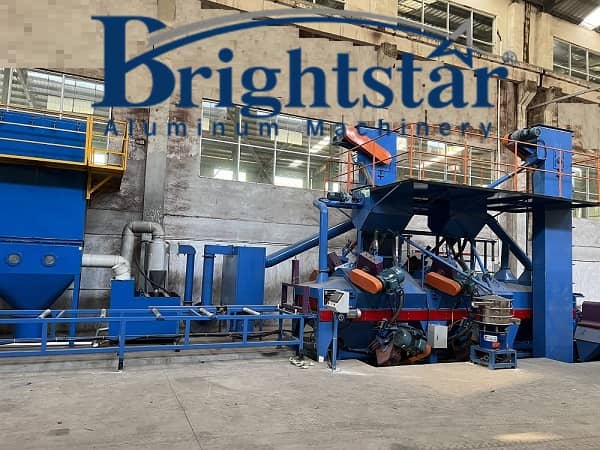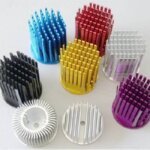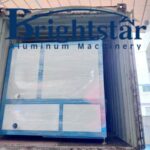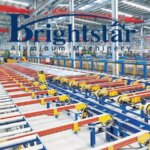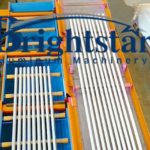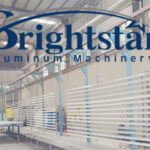Causes and management methods of color shade of sandblasted aluminum profile
Causes and management methods of color shade of sandblasted aluminum profile
Abstract: With the development of industrial aluminum products, the market has increasingly higher requirements for the appearance of highly decorative aluminum products.
Coupled with the country’s emphasis on environmental protection, common anodized or electrophoretic aluminum profiles, which use physical effects to form a sand surface effect on aluminum profiles, remove mechanical lines, and obtain a Matt effect, have developed very rapidly in recent years.
In principle, the process is subdivided into sand blasting and shot blasting.
However, due to their similar appearance and effect, the two are commonly referred to as sandblasting in the aluminum profile industry.
And sandblasted aluminum color shade often occurs during the production process of profiles.
This article only describes the reasons for the color shade of sandblasted aluminum profiles and matters worth noting during the production management process.
Keywords: sand blasting; shot blasting; anodizing; sand surface; color shade; roughness; hardness
Causes and management of color difference of sandblasted aluminum profile
Sandblasting is a mechanical pre-treatment method for anodizing and electrophoresis surface treatment of aluminum profiles.
During the sandblasting production process, the aluminum profiles are blasted with high-speed small particles.
The collision of hard objects creates an uneven texture on the surface.
According to the working principle, it can be divided into air sand blasting and centrifugal force shot blasting.
Whether it is sandblasting or shot blasting, the surface of the aluminum profile is treated to form a concave and convex sand surface effect.
In order to facilitate management, the industry is habitually referred to as sandblasting treatment.
Aluminum profiles have the following advantages through sandblasting:
⭐It can remove the oxide film on the surface of aluminum profile products.
The naturally formed oxide film can be removed by sandblasting.
This is why the sandblasting process precedes the anodizing process.
⭐ Prepare for other surface treatment processes, aluminum profiles after sandblasting, the electrophoretic paint film has stronger binding force in the process.
⭐Improve the mechanical properties of aluminum parts.
Sandblasted aluminum parts can increase the roughness by 0.1-0.5μm.
There are also tiny depressions on the surface of the parts that can store lubricating oil.
The lubrication effect is better, thereby extending the length of aluminum parts. service life and reduce mechanical operating noise.
⭐ Removing tiny burrs from aluminum profile parts, especially precision parts, has very high requirements for smoothness.
Tiny burrs will cause defects in the parts.
For example, 3C communication parts, textile machinery parts, aerospace precision parts, medical equipment parts, etc.
After sandblasting treatment, tiny burrs can be removed and a smooth surface can be obtained.
⭐ Solve the problem of metal reflection.
Some aluminum products are strictly prohibited from being reflective.
For example, for some surgical instruments, sandblasting is an effective solution.
⭐ Through sandblasting, the damage to the environment caused by the sanding process of chemical corrosion is solved, and low-cost and environmentally friendly production is achieved.
Sandblasted aluminum profiles have many benefits, so the industry has developed very rapidly in recent years, but color shade problems are prone to occur during the production process.
Through this post on the color formation principle and combined with production experience, we analyze the reasons for the color shade of sandblasted profiles in each link of the aluminum profile production process, and describe the management details worth noting in production.
Principle of color formation of sandblasted aluminum profiles
Color is an objective existence with colored light as the main body.
This kind of visual perception is based on three factors: light, the reflection of light by objects, and the human visual organ eyes.
That is, visible light of different wavelengths is projected onto an object, part of the wavelength of light is absorbed, and part of the wavelength of light is reflected to stimulate the human body.
The eyes transmit it to the brain through the optic nerve to form the color information of the object, that is, human color perception.
The function of light and the characteristics of objects are two indispensable conditions that constitute the color of objects.
They are interdependent and restrict each other.
Only emphasizing the characteristics of the object and denying the role of the color of the light source, the color of the object becomes a waterless source;
Only emphasizing the role of the color of the light source without recognizing the inherent characteristics of the object also denies the existence of the color of the object.
Therefore, under the same light source and human eyes, due to the different reflection of light by sandblasted aluminum profiles and pre-processed aluminum profiles such as without surface pretreatment and polished, sandblasted aluminum profiles show a unique texture, which is commonly known as sand surface.
This kind of sand surface is formed by the uneven surface of aluminum profile after sandblasting.
The degree of unevenness affects the reflection of light, thereby affecting the color perception of the human eye.
Whether it is natural oxidation or electrolytic coloring, the degree of surface unevenness will eventually affect the color of the profile.
If it is not managed, it will easily form different degrees of color shade.
Causes and management points of color shade in sandblasted aluminum profile
1. Mill finish aluminum profile
Due to the sandblasting production process, the aluminum profile is collided with high-speed small particles of hard objects to form an uneven texture on the surface, so the final effect is determined by the state of both the aluminum profile itself and the small particles of hard objects.
The quality of mill finish aluminum profile is often a link that is often ignored by sandblasting operator.
The state of mill finish aluminum profile that determines the sandblasting effect includes alloy composition of mill finish aluminum profiles, extrusion process, and die lines on mill finish aluminum profiles.
1.1 Alloy composition of mill finish
The alloy composition of mill finish aluminum profile is one of the most important factors affecting the hardness of aluminum profiles.
The conventional aluminum alloy grades currently in use generally have a higher degree of alloying.
The higher the hardness, the lower the unevenness formed after sandblasting, and the weaker the diffuse reflection of light.
At the same time, the ratio of different components in the alloy also affects the grain state and hardness of the aluminum profile, which ultimately affects the surface effect after sandblasting.
Due to the inherent physical properties of certain elements in aluminum alloys, the elements themselves affect the natural color of aluminum profiles, such as chromium. When a certain amount of chromium is added to the mill finish aluminum profile, the oxide film will appear slightly yellow.
Therefore, quality management of sandblasted aluminum profiles should start from the most source process.
Aluminum alloy melting and casting requires detailed alloy control ranges and alloy composition inspection before and after the furnace to ensure stable aluminum alloy production.
1.2 Extrusion process
The extrusion process is an important factor affecting the hardness of aluminum profiles.
The aluminum profile extrusion process determines the process of various crystal dislocations, alloy solid solution, and strengthening phase precipitation of aluminum alloys.
Therefore, each link in the extrusion process affects the hardness of the aluminum profile, and ultimately affects the sandblasting effect.
Therefore, stable quality management is required from aluminum billets heating to aging strengthening.
For example, when heating aluminum billets, the uniformity of the billet temperature should be controlled as much as possible.
From the uniformity of the billet temperature, the heating methods of the aluminum billets should be ranked: frequency heating furnace>single-billet billet heating furnace>multi-billets heating furnace.
Considering the stability of quality from the perspective of solution quenching, water cooling of high temperature and low speed extrusion has better solid solution effect and more stable hardness than air cooling of low temperature and high-speed extrusion.
The aging process must consider the density of profiles and the uniformity of the furnace temperature.
It is very necessary to conduct regular furnace temperature inspections of the aging furnace.
1.3 Die line of mill finish aluminum profile
Severe die lines on mill finish aluminum profiles affect the light reflection effect after sandblasting.
Because of severe extrusion lines, sandblasting cannot completely cover them.
When light irradiates the line area, part of the light is reflected at an angle different from that of the sandblasted profile without die lines, which will eventually lead to sensory differences in viewing angles and chromatic aberration.
The die lines depend on the quality of the aluminum billet, extrusion management and the state of the mold.
Harder substances such as iron compounds in the aluminum billet will easily cause the mold life to be reduced, so homogeneous aluminum billets can improve the die lines of aluminum extrusion.
Extrusion management stipulates the quality standards for unloading the mold after the working belt of the mold is worn, and even limits the production number of aluminum billets in the mold and other management measures to ensure the stability of the die lines of aluminum extrusion.
For new molds, quality standards should be formulated before the new mold is put on the machine, and the quality of the profile should be confirmed after the mold trial.
2. Sand blasting process
The sandblasting process directly affects the quality of sandblasting.
The sandblasting process mainly controls the material of the sand grains, the size of the sand grains, the pressure of high-pressure air, the frequency of the shot blasting electrode, the profile feed speed, the profile placement spacing, etc.
The effect of sandblasting affects the final light reflection and determines the appearance color of the aluminum profile.
2.1 Sand material and particle size
Sandblasting methods are divided into air sandblasting and centrifugal force shot blasting.
Although both provide sand particles to hit the surface of aluminum profile at a certain speed, their effects are different.
Due to the limited power of air in air sandblasting, the sand material can only be lighter, low-density quartz sand.
For shot blasting, the dense iron shots, stainless steel shots, copper shots, etc. can be used.
Because the quartz sand is slightly low, it is easy to break during the sandblasting process, resulting in a smaller diameter of the sand particles and unstable quality.
Therefore, when using air sandblasting, the quartz sand must be filtered and replenished regularly.
In shot blasting, due to the high strength of the sand grains, they are not easily damaged, the diameter of the sand grains is more uniform, the loss is less, and the surface quality of the shot blasting is relatively stable.
Therefore, the probability of color difference in shot blasting products using harder materials is relatively small.
2.2 Sand injection speed
The jet speed of the sand particles represents the energy of the sand particles colliding with the surface of the aluminum profile.
The faster the speed, the greater the energy, and the greater the unevenness of the surface of the aluminum profile.
The sand injection speed is determined by the air pressure of the air sandblasting and the speed of the shot blasting motor.
Both can be controlled and tested through corresponding methods.
Air sandblasting can be controlled through pressure gauges and pressure control valves, and the speed of the shot blasting motor can be controlled through a frequency converter.
These two parameters should be stipulated and process registered in daily production management to better ensure the quality of sandblasting.
2.3 Feeding speed
The feeding speed refers to the traveling speed of the aluminum profile entering the sandblasting area.
The speed determines the number of sand collisions the profile surface receives within a certain period of time.
The slower the feeding speed, the more times the sand particles collide on the surface of aluminum profile, and the more uniform the sand surface is.
The feeding speed directly affects production efficiency.
In daily management, parameters are often obtained and the importance of the feeding speed is ignored.
The difference in feed speed will affect the surface light reflection angle after the aluminum profile is sandblasted.
Therefore, the feeding speed is not only a representative of production efficiency, but also a key control point of product quality.
3.Other factors
3.1 Appearance quality inspection
Appearance quality inspection after sandblasting is an important link that most sandblasting managers ignore.
At present, sandblasting quality inspection generally adopts visual methods.
There is a lack of quantitative inspection standards, quantitative inspection data, and data analysis that can guide management.
Therefore, sandblasting quality inspection requires the use of surface roughness, glossiness, and SEM electronic scanning microscopes to formulate sandblasting standards from multiple aspects and angles, and collect data in daily routines for statistical analysis to guide the continuous improvement of sandblasting quality.
3.2 Anodizing process
The color shade of sandblasted aluminum profiles is also the color difference after anodizing, so the anodizing process cannot be ignored when considering the color shade of sandblasted aluminum profiles.
The sodium hydroxide corrosion in the anodizing process can corrode and smooth the adjacent corners shown by sandblasting;
Different anodizing current densities also determine the number and structure of oxide film pores;
For coloring aluminum profiles, the amount of metal deposited during the electrolysis process also directly affects the appearance color.
Therefore, the anodizing process should be managed as standardized as possible to avoid the occurrence of multiple color shade factors.
Conclusion
Sandblasted aluminum profiles that cater to consumer aesthetics and meet national environmental protection policies will surely become the mainstream of anodized surface treatment of aluminum profiles in the future.
Low-threshold processing technology and equipment are also areas that are easy for most aluminum profile manufacturers to enter.
However, how to stably provide a large number of high-quality sandblasted aluminum profiles still requires consideration of various influencing factors to achieve stable production as much as possible.
Brightstar Aluminum Machinery provides aluminum profile automatic shot blasting machine for our customers, not only the machine, but also the solution, turnkey project and package deal.
Contact us now to obtain a reliable no-obligation quote on your aluminum profile shot blasting machine.
Get A No-obligation Quote
